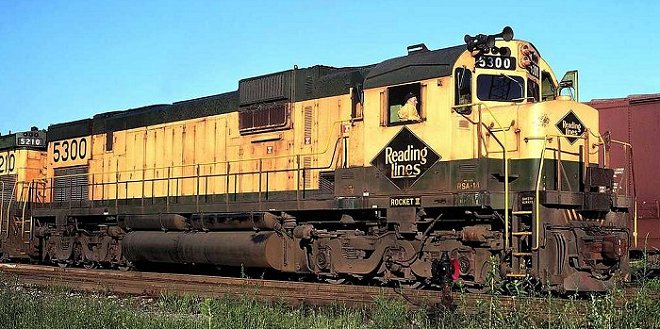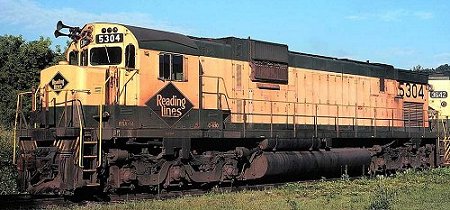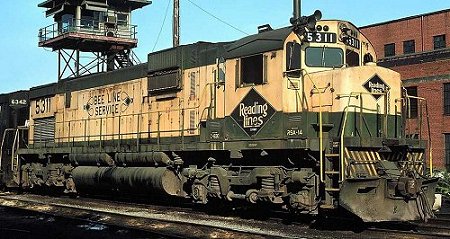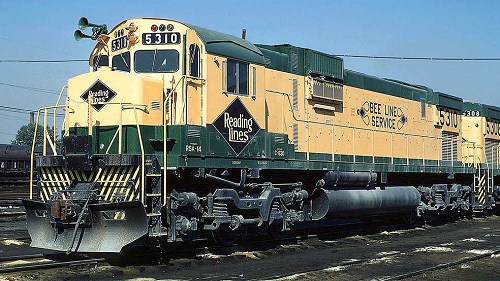Alco: Century 630

In the mid-1960s the Reading decided to acquire high-horsepower six-axle locomotives as part of its efforts to modernize its motive power fleet. Prior to the arrival of 5 EMD SD45 and 5 GE U30-C units, the railroad took delivery of seven Alco Century 630 locomotives in June, 1966. These 3000-horsepower brutes were the the longest locomotives on the Reading, and at the time were the first new six-axle power on the railroad since the Reading's Fairbanks-Morse Trainmasters were purchased. These locomotives were numbered 5300 through 5306, and were delivered in the 1960s yellow-and-green paint scheme. C630 #5300 was given the name "Rocket II" and christened in July 1966 along with the Reading's two smaller four-axle C430 locomotives, #5211 and #5212, with a nameplate mounted on the cab sides underneath the Reading diamond.
 The Reading's C630s were originally used in ore service between Port Richmond and Bethlehem, on the Bethlehem Branch, where 3 of the new locomotives could replace 5 Alco RS-3s. After their initial shakedown, since ore extras were only called at certain times subject to the docking of ore carriers at Port Richmond, the C630s were put into mainline freight service, paired as was common Reading practice with a four-axle unit. Reading #5304 at right appears to have spent some recent time in ore service, given the reddish cast of her weathering.
The Reading's C630s were originally used in ore service between Port Richmond and Bethlehem, on the Bethlehem Branch, where 3 of the new locomotives could replace 5 Alco RS-3s. After their initial shakedown, since ore extras were only called at certain times subject to the docking of ore carriers at Port Richmond, the C630s were put into mainline freight service, paired as was common Reading practice with a four-axle unit. Reading #5304 at right appears to have spent some recent time in ore service, given the reddish cast of her weathering.
 In October of the following year, the Reading took delivery of five more units numbered 5307 through 5311. In comparing the photo at left to the image above, one will note that there are several readily visible differences between the two groups of locomotives within this class. First, the locomotives ride on two different types of trucks. The initial units were delivered with Alco's "Tri-Mount" trucks, but the later group rode on Alco's "Hi-Adhesion" truck due to the Reading's experiencing several problems with the earlier variant. Next, 5307-5311 had snowplow pilots, while the earlier units did not. Also, the size of the Reading diamond on the rear of the hood was larger. Finally, only locomotives 5307 - 5311 carried the "Bee Line Service" logo on their long hood. In 1970, C630s #5302 and #5303 were put into hump service at Rutherford for about eight months, and had footboards installed on the pilots for this purpose. They were later returned to the road. During the significant downturn in traffic in 1975, the entire class was put into storage (5300-5306 at Reading, 5307-5311 at Rutherford) until after the creation of Conrail on April 1, 1976.
In October of the following year, the Reading took delivery of five more units numbered 5307 through 5311. In comparing the photo at left to the image above, one will note that there are several readily visible differences between the two groups of locomotives within this class. First, the locomotives ride on two different types of trucks. The initial units were delivered with Alco's "Tri-Mount" trucks, but the later group rode on Alco's "Hi-Adhesion" truck due to the Reading's experiencing several problems with the earlier variant. Next, 5307-5311 had snowplow pilots, while the earlier units did not. Also, the size of the Reading diamond on the rear of the hood was larger. Finally, only locomotives 5307 - 5311 carried the "Bee Line Service" logo on their long hood. In 1970, C630s #5302 and #5303 were put into hump service at Rutherford for about eight months, and had footboards installed on the pilots for this purpose. They were later returned to the road. During the significant downturn in traffic in 1975, the entire class was put into storage (5300-5306 at Reading, 5307-5311 at Rutherford) until after the creation of Conrail on April 1, 1976.
MODELING NOTES: The above text notes most of the differences between the two groups of Reading C630s: The trucks, snowplows, Reading diamond size, and the "Bee Line Service" logo (or lack thereof). Also take note of the classification lights above the cab windows; these are a feature found on all Reading Alco Centuries. The colors of the lenses, from center outward, were red, green, white. Bowser now makes C630s with both Tri-Mount and Hi-Ad trucks, so it's now possible to accurately model the Reading C630 fleet. None of these units were painted into the 1970s "all-green" scheme (though it would have been interesting to see what that looked like!). Operationally, these units would be seen in mainline service only, most often running in multiple with other four- or six-axle power. Due to their size and weight, they would not be appropriate for operation on some of the Reading's lighter branchlines like the Reading & Columbia or Wilmington & Northern. These locomotives were some of the most impressive units on the Reading, and will be sure to catch the eye of visitors to your layout!

Did You Know?
Downloads
 A variety of Reading Company operations related documents, etc. that may be of use in your modeling efforts.
A variety of Reading Company operations related documents, etc. that may be of use in your modeling efforts.
 A variety of Reading Company operations paperwork, such as train orders, clearance forms, etc. that will help you operate your Reading layout in a prototypical manner.
A variety of Reading Company operations paperwork, such as train orders, clearance forms, etc. that will help you operate your Reading layout in a prototypical manner.
 Public Timetables, Employe Timetables, and Rulebooks that provide much useful operational information.
Public Timetables, Employe Timetables, and Rulebooks that provide much useful operational information.
 Signs, billboards, and other FREE goodies for your use. We ask only that you help spread the word about The Reading Modeler!
Signs, billboards, and other FREE goodies for your use. We ask only that you help spread the word about The Reading Modeler!

